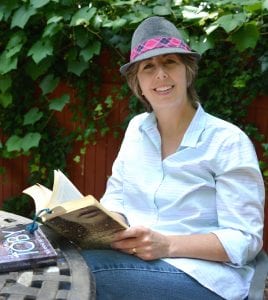Reviewed by Jeffrey Sanzel
The prolific Ellen Meister’s tenth novel, Joyride, offers a fascinating portrait of the (almost) unflagging optimist Joybird Martin, whose desire to help leads her to create a hybrid of Uber and life coaching. The unique premise—and Joybird’s dream—is more than a gimmick. Her genuine drive to heal is a passion rooted in her history.

Joybird’s parents divorced when she was a child. Her father, Sid, moved to Los Angeles to pursue a career as a television writer, and she remained in Brooklyn with her mother. When she was eight, her mother died, and Joybird spent a short time living with Sid on the West Coast. After the cancellation of his television show, he and Joybird relocated to his family home in Connecticut. With a career turnaround, he moved back to L.A., leaving her with her maternal grandparents in Queens, where she remained until she left for college. After his third marriage collapsed, he failed to keep in touch.
When Joyride opens, Joybird is thirty-one and living alone in Brooklyn. Due to an implied #MeToo incident, Sid shows up jobless and homeless. Simultaneously abrasive and hyper-sensitive, Sid devolved into a perpetual victim, incapable of self-care. He has moments of acerbic reflection—“like most barbarians, I have strong opinions”—but remains a work in progress.
Like her pale-blue Honda Accord, Joybird is “earnest and dependable.” She is easily judged by her perpetually upbeat outlook. “People underestimate[ed] her because of her cheerfulness. But it was her philosophy that you don’t have to be stupid to be happy.” Her father lives in direct contrast. “Sid Marcus had been quick to feel victimized, insisting that life dealt him a crappy hand, skimming the best cards for someone else.” His long-rooted cynicism dates to his earliest days in Hollywood: privileged Connecticut-born John Martin changed his name to Sid Marcus because he felt it was the only way he could get ahead in the entertainment industry.
Equity analyst Devon Cato, an Uber rider, inspires Joybird to embark on a mobile office. He quickly becomes smitten with her, creating a romantic triangle with a Bohemian poet, Noah Pearlman. The contrast between Cato and Pearlman is not as simple as it initially appears, and Meister wisely lets the dueling relationships unfold throughout the narrative.
 Among her clients are the catfished Althea and the fifteen-year-old Riley, the latter struggling with indifferent parents and teenage angst. Again, Meister chooses not to shy away from easy roads or facile solutions. Guiding Joybird as a voice of reason is the upstairs neighbor, the youthful septuagenarian Betty, whose perfume “was an old-fashioned scent that made Joybird think of movies from the 1970s and big hoop earrings.” Betty functions as a friend and mother figure, advising the impossibility of always making people happy: “That’s a burden no one should have to carry.” The simple statement resonates deeply as Joybird’s newfound career presents unexpected landmines.
Among her clients are the catfished Althea and the fifteen-year-old Riley, the latter struggling with indifferent parents and teenage angst. Again, Meister chooses not to shy away from easy roads or facile solutions. Guiding Joybird as a voice of reason is the upstairs neighbor, the youthful septuagenarian Betty, whose perfume “was an old-fashioned scent that made Joybird think of movies from the 1970s and big hoop earrings.” Betty functions as a friend and mother figure, advising the impossibility of always making people happy: “That’s a burden no one should have to carry.” The simple statement resonates deeply as Joybird’s newfound career presents unexpected landmines.
Meister weaves Joybird’s efforts to reunite Sid with his high school crush and her own romantic challenges, along with the trials of her clients. She writes with the ease and brightness of Armistead Maupin, giving her New York and its boroughs a vibrant energy. Her characters are not standard “quirky” but richly detailed and fully realized.
Like with her protagonist in Take My Husband (who settles her nerves with an initials word game), Meister fleshes out Joyride’s ensemble with textured, believable personalities. Whether describing the dress of one of Sid’s wealthy clients—“indigo jeans with cognac-colored loafers and no socks”—or the fragrance of a dissipated cologne that leaves Joybird with a “lingering undertone of regret”—Meister possesses an evocative, visceral sense of detail.
Just as in her outstanding Farewell, Dorothy Parker, Meister writes with wit and warmth, creating complex characters whose ability to change is through a combination of adversity, choice, and personal reflection.
Ultimately, Joyride addresses a world where one must navigate between support and exploitation.
“Joybird knew exactly why she hadn’t seen it — her sunny faith in people sometimes blinded her to bad behavior. But she shrugged it off as a small price to pay for the privilege of living her life in the bright, white light of optimism.” Ellen Meister’s Joyride is an engaging, brisk, humorous, and satisfying journey of a person who genuinely believes “we all deserve a chance to become our best selves.”
Pick up a copy of Joyride at your local bookseller or online at www.amazon.com or www.barnesandnoble.com. For more information, visit ellenmeister.com.







 The Lubinskis remain with Izzy and Faye as the girls grow up. Aron has actively chosen not to reveal his nor Edyta’s history to the girls.
The Lubinskis remain with Izzy and Faye as the girls grow up. Aron has actively chosen not to reveal his nor Edyta’s history to the girls.









